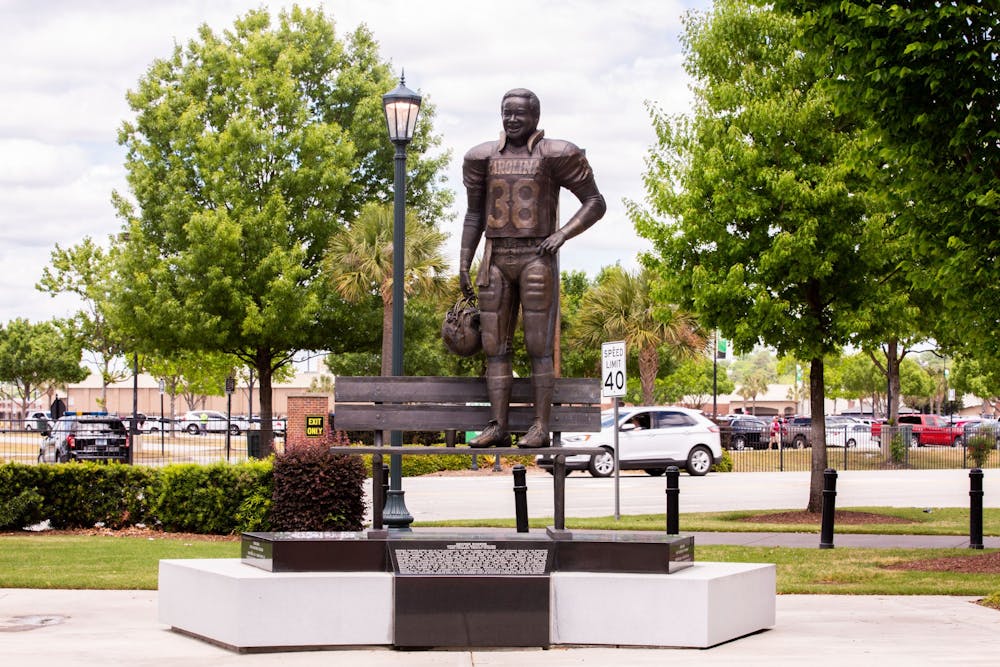Some of the first Black athletes to play at South Carolina athletics, such as Jackie Brown, Casey Manning, Sheila Foster and George Rogers, were formative and important to shaping the current look of Gamecock athletics.
Ansel “Jackie” Eugene Brown made history in fall 1970, earning a starting spot on the Gamecock football team and becoming the first Black varsity athlete at South Carolina.
Brown originally ended up at USC on a baseball scholarship but was approached by the football team for a tryout. In a week, Brown had a full-ride scholarship to play football along with a starting spot on the team.
In his senior and best season, Brown recorded 32 receptions for 436 yards. After that, Brown was drafted by the Baltimore Colts but suffered a career-ending hamstring injury.
Brown was the first Black athlete to letter on a varsity team, but Carlton Haywood was the first to be recruited by a varsity team and, if not redshirted in the 1970 season, would have lettered in the same season as Brown.
Casey Manning was another pioneer for Black athletes at South Carolina, becoming the first Black player on the basketball team in1970. However, Manning was reluctant to be the trailblazer for the basketball team.
Willie T. Smith III, a former sports writer at the Greenville News and a USC alumnus, spoke about Manning's legacy.
“[Manning] actually told me that he didn’t want to be the first Black basketball player,” Smith said. “He wanted to go to Davidson, but I guess he — some coaches in his area, and family and other people, kind of talked him into coming to South Carolina and being the first.”
Alex English, who played with Casey Manning in ‘72, racked up 1,972 points while playing from 1972 to 1976. The South Carolina basketball legend instantly became the all-time scoring leader.
In an interview with the Big Spur in 2019, South Carolina men’s basketball head coach Frank Martin said English "could get 40 on you and not even break a sweat.”
After his career with the Gamecocks, English was drafted to the Milwaukee Bucks in ‘76. English went on to play in the NBA for 15 years, spending 10 of them with the Denver Nuggets from 1980 to 1990, becoming its all-time leading scorer as well.
Sheila Foster, a women’s basketball legend, played for the Gamecocks from 1977 to 1982. In her four-year career, Foster broke multiple program records, including for rebounds (1,427) and points (2,266).
“Back then they did not have a free throw line, and a lot of her shots would have been 3-pointers, so who knows how many points she would have had if they had a 3-point line back then,” Smith said.
Foster’s career led to her jersey being retired in 1982, becoming the first woman in South Carolina athletics history to receive this honor.
George Rogers played football at USC from 1976 to 1980. In his four seasons, Rogers rushed for 5,091 total yards and 31 touchdowns. However, Rogers said he did not play very much in the beginning of his career.
“I started out crying cause they wouldn’t let me play,” Rogers said. “Coach put me in the game, I was crying, he said, ‘OK, OK, we’re going to put you in,’ and they gave the ball to me. I went around that corner, and I ain’t saw nobody yet.”
Even though he said he’d only play one or two quarters in some games, Rogers rushed for 1,781 yards and 14 touchdowns.
Going into his senior season, Rogers got word that he was being nominated for the Heisman Trophy, so he knew he had to show out.
“My offensive line said, ‘He’s up for the Heisman, we’re going to block, we’re going to make sure we block well for him,'” Rogers said. “I always thought, you go as far as your offensive line will take you, and boy, we were rolling.”
His campaign that season solidified him as the best player in the country, as he went on to win the Heisman Trophy. Rogers gave all the credit to his offensive line during his Heisman acceptance speech.
“There was no way I could have been prepared,” Rogers said about the Heisman ceremony.
After college, Rogers was drafted first overall by the New Orleans Saints and, in his rookie season, rushed for 1,674 yards, setting a rookie season record at the time.
He now sits in second place all-time, just 134 yards behind Eric Dickerson.
In his seven-year NFL stint, Rogers played for the Washington Redskins after the Saints and won a Super Bowl with theRedskins in 1987.
Without these Gamecock athletes, the teams we know today would look much different.

